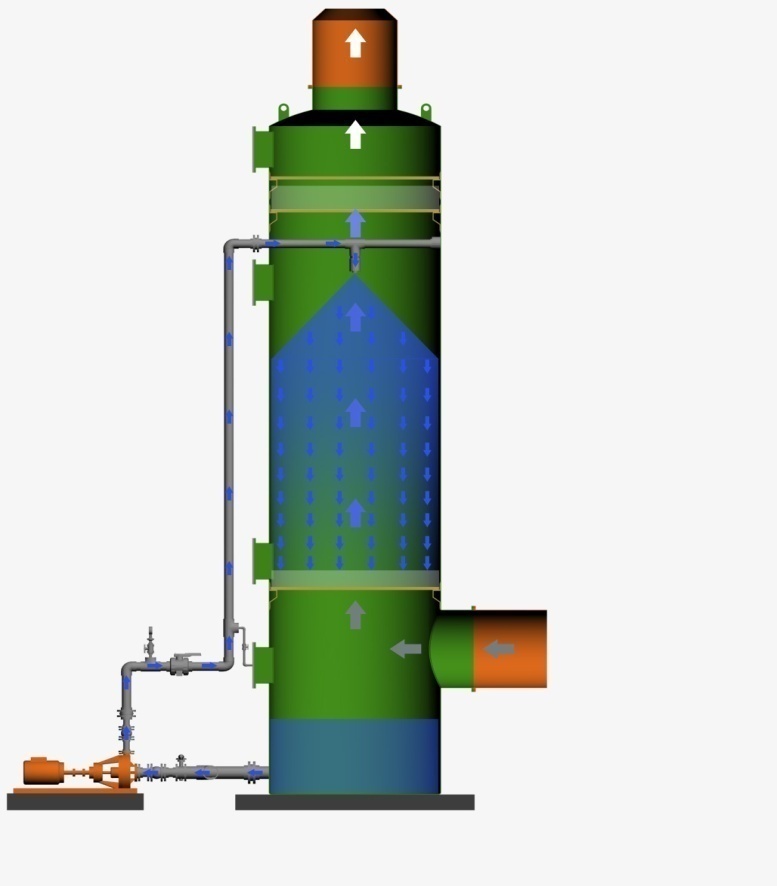Wet Scrubber
Wet Scrubbing Air Pollution Control System
In a typical chemical scrubbing system, the polluted air is ventilated to the filter by a fan. The extracted air is pushed into one or several chemical scrubber(s) for treatment. The polluted air is passed through a packing media where it comes into intimate contact with the scrubbing solution containing chemical reagents. Similarly to all absorption processes, the polluted gases are first dissolved into the liquid phase and then react with the chemical agents. Clean air is then discharged through a stack installed on top of the scrubber. Where multiple pollutants are present in a gas stream, normally a wet scrubber system is selected due to the possibility of utilizing different chemical agents in each stage for the removal of the specific gaseous contaminants. We remove a complete range of inorganic and organic gases. Our SO2, NO, NO2, HCl, Cl2, HBr, Br2, Ethanol, and MEK scrubbers have a proven record of achieving the most stringent standards. Treatment could be conducted in 1, 2 or 3 different stages, therefore the removal efficiency in a typical chemical scrubber system may reach up to 99.99% or even higher if needed!

Scrubbing liquid is recirculated in a chemical scrubber by a recirculation pump. Also, a water softener may be used for make-up water. A chemical dosing system including storage tanks and dosing pumps are also the main components of the system.
Clean air is then discharged through a stack installed on top of the scrubber. Treatment could be conducted in 1, 2 or 3 different stages, therefore the removal efficiency in a typical chemical scrubber system may reach up to 99.99% or even higher if needed! Scrubbing liquid is recirculated in a chemical scrubber by a re-circulation pump. Also, a water softener may be used for make-up water. A chemical dosing system including storage tanks and dosing pumps are also the main components of the system.
AAI’s Chemical Scrubbing Technique

Wet scrubbers have been used successfully for many years as air pollution control devices to remove pollutants from air streams containing both gases, liquid or solid particulates. Where multiple pollutants are present in a gas stream, normally the wet scrubber is selected due to its capability of removing gaseous contaminants by gas-liquid diffusional processes as well as eliminating liquid and solid particulates by mechanisms of inertial impaction, cyclonic motion or interception.
However, wet scrubber designs vary widely in their mass transfer and particulate collection capability. Engineers selecting such equipment must be careful to examine factors such as available mass transfer units, pressure drop, required removal efficiency and reliability of the operation.
Chemical scrubbing is ‘differential’ in nature such that absorption efficiency is a function of packing depth and normally a packed scrubber can be designed to give any desired collection efficiency. AAI’s design of the scrubber housing considers factors such as shell, bottom and top thickness, flat foundation, maximum corrosion resistance for interior and exterior surfaces to ensure long service life, strong internal supports and access ports for ease of maintenance. GRP as the material of construction offers low weight, low operating cost and long service life. Additionally, AAI’s experience with the selection of appropriate resin, liner and curing system for our scrubbers and vessels guarantees a long and carefree performance.
Liquid distribution system using removable large orifice, low pressure drop nozzles with full cone spray patterns provide good initial distribution, which is highly important with K-Rosette packing. The Open configuration of AAI’s K-Rosette packing reduces the possibility of misdistribution, while highly efficient and low pressure drop Chevron type mist eliminator section prevents any droplet carry-over.
AmerAir's Packing Material "K-Rosette“

A filamentous packing such as K-Rosette removes liquid and solid particulates by the mechanism of inertial impaction. This packing offers a series of ribbons with small width to keep deviation of the gas stream and the resultant energy consumption to a minimum. The cross section of the K-Rosette filament is square giving it sharp edges and higher target efficiency than spherical or cylindrical shapes of the same width.
Extended surface packings have a much higher pressure drop because a large proportion of the so-called free volume in a random packed bed is not available for gas flow and is actually dead. The large extended surface typical with this type of packing presents large obstruction to the gas stream, which must pass through in a tortuous manner causing high energy loss. With K-Rosette, the gas flow is restricted only by the friction of the small filament and no severe direction changes are required.
